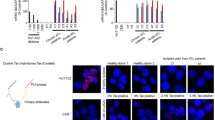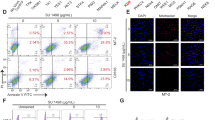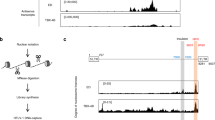Abstract
The Tax proteins of the oncovirinae viruses are phosphorylated transcriptional activators that exhibit oncogenic potential. The role of phosphorylation in their functional activities remains unknown. As a model for the Human T-cell leukemia virus type I (HTLV-I), Bovine Leukemia Virus (BLV) permits the characterization of viral replication and leukemogenesis in vivo. Here, we show that the BLV Tax protein is phosphorylated on serine residues 106 and 293 both in insect and in mammalian cells. These sites can also be efficiently phosphorylated by the cdc2 and MAP kinases in vitro. Mutation of these residues does not affect the capacity of the Tax protein to function as a transactivator. Indeed, the Tax proteins mutated at one or both serines increase LTR-directed viral transcription at levels similar to those obtained with wild-type Tax in cell culture. Moreover, inhibition of Tax phosphorylation by W7, a calmodulin antagonist, does not alter its transactivation activity. Thus, phosphorylation on serines 106 and 293 is not required for transactivation by Tax. However, simultaneous substitution of both serines into alanine residues destroys the capacity of Tax to cooperate with the Ha-ras oncogene to transform primary rat embryo fibroblasts and induce tumors in nude mice. When the serines were replaced with aspartic acid residues, the oncogenic potential of Tax was maintained indicating that the negative charge rather than the phosphate group itself was required for Tax oncogenicity. Finally, to assess the role of the serine residues in vivo, recombinant viruses which express the Tax mutants were constructed and injected into sheep. It appeared that the mutated proviruses replicate at levels similar to the wild-type virus in vivo. We conclude that Tax phosphorylation is dispensable for transactivation and viral replication in vivo but is required for its oncogenic potential in vitro.
This is a preview of subscription content, access via your institution
Access options
Subscribe to this journal
Receive 50 print issues and online access
$259.00 per year
only $5.18 per issue
Buy this article
- Purchase on SpringerLink
- Instant access to full article PDF
Prices may be subject to local taxes which are calculated during checkout
Similar content being viewed by others
Author information
Authors and Affiliations
Rights and permissions
About this article
Cite this article
Willems, L., Grimonpont, C., Kerkhofs, P. et al. Phosphorylation of bovine leukemia virus Tax protein is required for in vitro transformation but not for transactivation. Oncogene 16, 2165–2176 (1998). https://doi.org/10.1038/sj.onc.1201765
Received:
Revised:
Accepted:
Published:
Issue date:
DOI: https://doi.org/10.1038/sj.onc.1201765
Keywords
This article is cited by
-
Overexpression of bovine leukemia virus receptor SLC7A1/CAT1 enhances cellular susceptibility to BLV infection on luminescence syncytium induction assay (LuSIA)
Virology Journal (2020)
-
A new genotype of bovine leukemia virus in South America identified by NGS-based whole genome sequencing and molecular evolutionary genetic analysis
Retrovirology (2016)
-
The pleiotropic protein kinase CK2 phosphorylates HTLV-1 Tax protein in vitro, targeting its PDZ-binding motif
Virus Genes (2010)
-
Mechanisms of leukemogenesis induced by bovine leukemia virus: prospects for novel anti-retroviral therapies in human
Retrovirology (2007)



